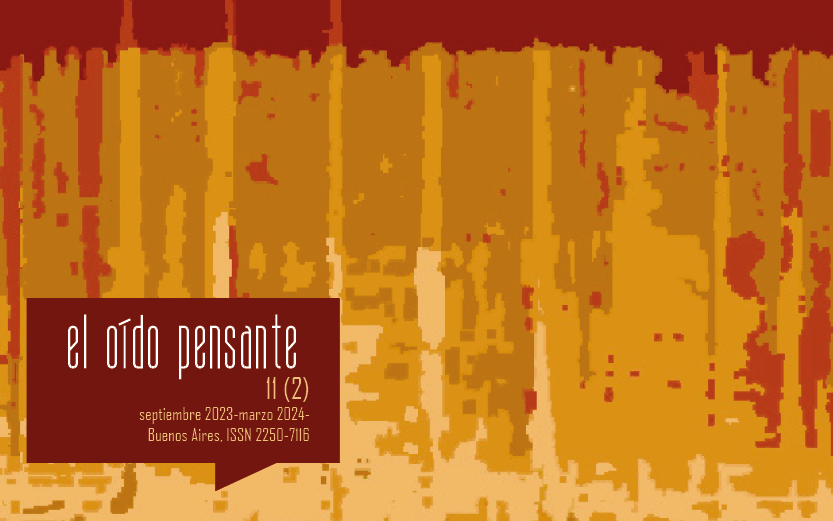Transgressões neoliberais na indústria cinematográfica contemporânea: música clássica e corpos musicais desumanizados nos filmes The Perfection (2018) e Nocturne (2020)
Resumo
O objetivo deste artigo é examinar o que chamo “corpos musicais deshumanizados” nos filmes de terror psicológico The Perfection e Nocturne. Esses corpos neoliberais multideficientes são expostos à imagem estereotipada e surpreendentemente negativa do mundo sofisticado da música artística. Particular atenção é dada ao tratamento provocativo da música erudita, com foco nas práticas institucionais não normativas e na reconfiguração ética dos seus representantes. Uma forma surpreendentemente crua de desumanização musical é encontrada no filme The Perfection, cuja trilha sonora combina sons ambientes de terror e músicas populares com grandes obras clássicas de Handel, Mozart e Casadesus. O filme Nocturne, por outro lado, oferece uma estética audiovisual mais contemplativa com uma hierarquização enganosa do repertório da música clássica. A música de Mozart é caprichosamente desvalorizada, enquanto o “Concerto para piano No. 2 em sol menor” de Saint-Saëns é usado como um dispositivo narrativo para uma manifestação destrutiva de poder que leva a uma avalanche de conflito entre as irmãs. Tal jogo explícito com os significantes da música clássica desvia-se drasticamente dos protocolos musicais convencionais e leva à alienação e, em última análise, à desumanização neoliberal transgressora dos músicos contemporâneos.Downloads
Referências
Adorno, T. W. (1976). Introduction to the Sociology of Music. New York: The Seabury Press.
Adorno, T. W. (1991 [1938]). On the Fetish Character in Music and the Regression of Listening. In J. M. Bernstein (Ed.). The Culture Industry. Selected Essays on Mass Culture (pp. 29-60). London: Routledge.
Adorno, T. W. (2002 [1941]). The Radio Symphony. In R. Leppert (Ed.). Essays on Music (pp. 251-270). Berkeley: University of California Press.
Attali, J. (1985 [1977]). Noise: The Political Economy of Music. Minneapolis: University of Minnesota Press.
Benjamin, W. (1997 [1968]). Theses on the Philosophy of History. In H. Zohn (Trans.). Illuminations: Essays and Reflections (pp. 253-265). New York: Schocken Books.
Bordwell, D. and Thompson, K. (2010). Film Art: An Introduction, 9th edition. New York: McGraw-Hill.
Bourdieu, P. (1984 [1979]). Distinction: A Social Critique of the Judgement of Taste. Cambridge: Harvard University Press.
Brown, W. (2015). Undoing the Demos: Neoliberalism’s Stealth Revolution. Cambridge, Mass: Zone Books, MIT Press.
Buhler, J. (2022). Composing for the Films in the Age of Digital Media. In G. Borio (Ed.). The Mediations of Music: Critical Approaches after Adorno (pp. 144-163). London and New York: Routledge. Doi: https://doi.org/10.4324/9781003166139-12
Buhler, J., Neumeyer, D. and Deemer, R. (2010). Hearing the Movies: Music and Sound in Film History. Oxford: Oxford University Press,
Buljančević, R. (2021). Ideological Aspects of Erotic Capital and Patriarchal Power Relations in the Visual Interpretations of Lola Astanova. New Sound International Journal of Music, 58(2), 98-116. https://doi.org/10.5937/newso2158098B
Buljančević, R. (2022a). Between Tradition and Subversion. Treatment of Folklorised Musical References in the Early Feature Films of Pedro Almodóvar. Muzikologija, 32, 161-181. Doi: https://doi.org/10.2298/MUZ2232161B
Buljančević, R. (2022b). Music in Pasolini’s The Decameron: Humour, Spirituality, (De)tabooisation and Playing with Conventional Signifiers of the Italian Musical Past. Zbornik Akademije umetnosti, 10, 130-155. Doi: https://doi.org/10.5937/ZbAkU2210130B
_____. Film, Music, and Migrant Identities: Representing Musical Otherness in Visconti’s Neorealist Drama Rocco and His Brothers. Resonancias, 27(52): 129-156. Doi: http://doi.org/10.7764/res.2023.52.7
Burke, E. (1990 [1759]). A Philosophical Enquiry into the Origin of our Ideas of the Sublime and Beautiful. New York: Oxford University Press.
Cormack, M. (2006). The Pleasures of Ambiguity: Using Classical Music Melodrama in Film. In P. Powrie and R. Stilwell (Eds.). Changing Tunes: The Use of Pre-Existing Music in Film (pp. 19-30). Aldershot: Ashgate.
De Clercq, R. (2011). Aesthetic Properties. In T. Gracyk and A. Kania (Eds.). Routledge Companion to Philosophy and Music (pp. 144-155). London: Routledge.
Fabbri, F. (2008). La escucha tabú. In M. García Quiñone (Ed.). La música que no se escucha: aproximaciones a la escucha ambiental (pp. 17-37). Barcelona: Orquestra del Caos.
Foucault, M. (1975). Surveiller et punir. Paris: Gallimard.
Foucault, M. (1980) “The Confession of the Flesh”. In C. Gordon (Ed.). Power/Knowledge: Selected Interviews and Other Writings 1972–1977 (pp. 194-228). Brighton: Harvester Press.
Fry, K. (2008). Elaboration, Counterpoint, Transgression: Music and the Role of the Aesthetic in the Criticism of Edward W. Said. Paragraph, 31(3), 265-279. Doi: https://doi.org/10.3366/E0264833408000278
Giroux, H. A. (2010). Neoliberalism, Pedagogy, and Cultural Politics: Beyond the Theatre of Cruelty. In L. Zeus (Ed.). Handbook of Cultural Politics and Education (pp. 49-70). Rotterdam: Sense Publishers.
Gorbman, C. (1987). Unheard Melodies: Narrative Film Music. Bloomington: Indiana University Press.
Greig, D. (2022). ‘Somewhat of an Affectation’: Bach, Vivaldi, and the Early Films of Pier Paolo Pasolini. Music and Letters, 103(1), 116-149. Doi: https://doi.org/10.1093/ml/gcab062
Halfyard, J. K. (2006). Screen Playing: Cinematic Representations of Classical Music Performance and European Identity. In M. Mera and D. Burnand (Eds.). European Film Music (pp. 73-85). Hampshire & Burlington: Ashgate Publishing Limited.
Harjunen, H. (2017). Neoliberal Bodies and the Gendered Fat Body. London and New York: Routledge.
Heldt, G. (2013). Music and Levels of Narration in Film: Steps across the Border. Bristol and Chicago: Intellect.
Huckvale, D. (2022). The Piano on Film. Jefferson: McFarald & Company, Inc.
James, R. (2019). The Sonic Episteme: Acoustic Resonance, Neoliberalism, and Biopolitics. Durham: Duke University Press.
Kramer, L. (2007). Why Classical Music Still Matters. Berkeley and Los Angeles: University of California Press.
Lowe, M. (2007). Pleasure and Meaning in the Classical Symphony. Bloomington: Indiana University Press.
Marcuse, H. (2002 [1964]). One Dimensional Man: Studies in the Ideology of Advanced Industrial Society. London and New York: Routledge.
McIver Lopes, D. (2022). How to Think about How to Think about Aesthetic Value. Journal of Aesthetics & Culture, 14(1), 1-9. Doi: https://doi.org/10.1080/20004214.2021.2010912
Ortega y Gasset, J. (1968 [1925]). The Dehumanization of Art and Other Essays on Art, Culture, and Literature. Princeton: Princeton University Press.
Pontara, T. (2021). Art Music, Perfection and Power: Critical Encounters with Classical Music Culture in Contemporary Cinema. Open Library of Humanities, 7(2), 1-25. Doi: https://doi.org/10.16995/olh.4675
Pope, A. (2006 [1728]). Peri Bathous, or the Art of Sinking in Poetry. In P. Rogers (Ed.). Alexander Pope: The Major Works (pp. 195-239). Oxford: Oxford University Press.
Ritchey, M. (2019). Composing Capital: Classical Music in the Neoliberal Era. Chicago: University of Chicago Press.
Said, E. W. (1991). Musical Elaborations. New York: Columbia University Press.
Schwarm, B. (2014). The Devil’s Trill. Encyclopedia Britannica. Retrieved from https://www.britannica.com/topic/The-Devils-Trill
Schwartz, J. M. (2019). Resisting the Norming of the Neoliberal Academic Subject: Building Resistance [a]cross Faculty Ranks. In C. Manathunga and D. Bottrell (Eds.). Resisting Neoliberalism in Higher Education Volume II: Prising Open the Cracks (pp. 65-88). Cham: Palgrave Macmillan.
Smith, D. L. (2014). Dehumanization, Essentialism, and Moral Psychology. Philosophy Compass, 9, 814-824. Doi: https://doi.org/10.1111/phc3.12174
Smith, D. L. (2016). Paradoxes of Dehumanization. Social Theory and Practice, 42(2), 416-443. Doi: https://doi.org/10.5840/soctheorpract201642222
Stilwell, R. J. (2007). The Fantastical Gap between Diegetic and Nondiegetic. In D. Goldmark, L. Kramer and R. Leppert (Eds.). Beyond the Soundtrack: Representing Music in Cinema (pp. 184-202). Berkeley, Los Angeles and London: University of California Press.
Varkøy, Ø. (2016). Pierre Bourdieu and the Autonomy of Art: The Idea of Art as Critique. In P. Burnard and Y. Hofvander Trulsson (Eds.). Bourdieu and the Sociology of Music Education (pp. 143-159). New York: Routledge.
Winkler, M. (1951). A Penny from Heaven. New York: Appleton-Century-Crofts.
Filmography
Chazelle, D. (2015 [2014]). [Dir.]. Whiplash. DVD. Culver City, CA: Sony Pictures.
Haneke, M. (2002 [2001]). [Dir.]. La Pianiste. DVD. New York: Kino International Corp.
Polanski, R. (2003 [2002]). [Dir.]. The Pianist. DVD. Australia: Universal Pictures.
Quirke, Z. (2020). [Dir.]. Nocturne. US: Amazon Studios. Retrieved from https://www.amazon.com/Nocturne-Sydney-Sweeney/dp/B08DXBQCPY
Shepard, R. (2019 [2018]). [Dir.]. The Perfection. DVD. Los Gatos, CA: Netflix.























